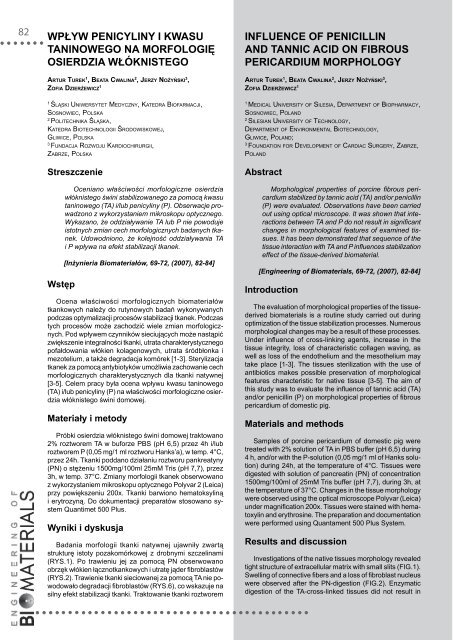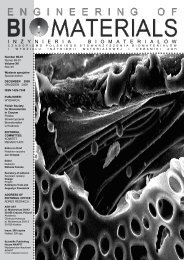69-72 - Polskie Stowarzyszenie BiomateriaÅów
69-72 - Polskie Stowarzyszenie BiomateriaÅów
69-72 - Polskie Stowarzyszenie BiomateriaÅów
Create successful ePaper yourself
Turn your PDF publications into a flip-book with our unique Google optimized e-Paper software.
82<br />
Wpływ penicyliny i kwasu<br />
taninowego na morfologię<br />
osierdzia włóknistego<br />
Artur Turek 1 , Beata Cwalina 2 , Jerzy Nożyński 3 ,<br />
Zofia Dzierżewicz 1<br />
Influence of penicillin<br />
and tannic acid on fibrous<br />
pericardium morphology<br />
Artur Turek 1 , Beata Cwalina 2 , Jerzy Nożyński 3 ,<br />
Zofia Dzierżewicz 1<br />
1<br />
Śląski Uniwersytet Medyczny, Katedra Biofarmacji,<br />
Sosnowiec, Polska<br />
2<br />
Politechnika Śląska,<br />
Katedra Biotechnologii Środowiskowej,<br />
Gliwice, Polska<br />
3<br />
Fundacja Rozwoju Kardiochirurgii,<br />
Zabrze, Polska<br />
Streszczenie<br />
Wstęp<br />
Oceniano właściwości morfologiczne osierdzia<br />
włóknistego świni stabilizowanego za pomocą kwasu<br />
taninowego (TA) i/lub penicyliny (P). Obserwacje prowadzono<br />
z wykorzystaniem mikroskopu optycznego.<br />
Wykazano, że oddziaływanie TA lub P nie powoduje<br />
istotnych zmian cech morfologicznych badanych tkanek.<br />
Udowodniono, że kolejność oddziaływania TA<br />
i P wpływa na efekt stabilizacji tkanek.<br />
[Inżynieria Biomateriałów, <strong>69</strong>-<strong>72</strong>, (2007), 82-84]<br />
Ocena właściwości morfologicznych biomateriałów<br />
tkankowych należy do rutynowych badań wykonywanych<br />
podczas optymalizacji procesów stabilizacji tkanek. Podczas<br />
tych procesów może zachodzić wiele zmian morfologicznych.<br />
Pod wpływem czynników sieciujących może nastąpić<br />
zwiększenie integralności tkanki, utrata charakterystycznego<br />
pofałdowania włókien kolagenowych, utrata śródbłonka i<br />
mezotelium, a także degradacja komórek [1-3]. Sterylizacja<br />
tkanek za pomocą antybiotyków umożliwia zachowanie cech<br />
morfologicznych charakterystycznych dla tkanki natywnej<br />
[3-5]. Celem pracy była ocena wpływu kwasu taninowego<br />
(TA) i/lub penicyliny (P) na właściwości morfologiczne osierdzia<br />
włóknistego świni domowej.<br />
Materiały i metody<br />
Próbki osierdzia włóknistego świni domowej traktowano<br />
2% roztworem TA w buforze PBS (pH 6,5) przez 4h i/lub<br />
roztworem P (0,05 mg/1 ml roztworu Hanks’a), w temp. 4°C,<br />
przez 24h. Tkanki poddano działaniu roztworu pankreatyny<br />
(PN) o stężeniu 1500mg/100ml 25mM Tris (pH 7,7), przez<br />
3h, w temp. 37°C. Zmiany morfologii tkanek obserwowano<br />
z wykorzystaniem mikroskopu optycznego Polyvar 2 (Leica)<br />
przy powiększeniu 200x. Tkanki barwiono hematoksyliną<br />
i erytrozyną. Do dokumentacji preparatów stosowano system<br />
Quantimet 500 Plus.<br />
Wyniki i dyskusja<br />
Badania morfologii tkanki natywnej ujawniły zwartą<br />
strukturę istoty pozakomórkowej z drobnymi szczelinami<br />
(Rys.1). Po trawieniu jej za pomocą PN obserwowano<br />
obrzęk włókien łącznotkankowych i utratę jąder fibroblastów<br />
(Rys.2). Trawienie tkanki sieciowanej za pomocą TA nie powodowało<br />
degradacji fibroblastów (Rys.6), co wskazuje na<br />
silny efekt stabilizacji tkanki. Traktowanie tkanki roztworem<br />
1<br />
Medical University of Silesia, Department of Biopharmacy,<br />
Sosnowiec, Poland<br />
2<br />
Silesian University of Technology,<br />
Department of Environmental Biotechnology,<br />
Gliwice, Poland;<br />
3<br />
Foundation for Development of Cardiac Surgery, Zabrze,<br />
Poland<br />
Abstract<br />
Morphological properties of porcine fibrous pericardium<br />
stabilized by tannic acid (TA) and/or penicillin<br />
(P) were evaluated. Observations have been carried<br />
out using optical microscope. It was shown that interactions<br />
between TA and P do not result in significant<br />
changes in morphological features of examined tissues.<br />
It has been demonstrated that sequence of the<br />
tissue interaction with TA and P influences stabilization<br />
effect of the tissue-derived biomaterial.<br />
[Engineering of Biomaterials, <strong>69</strong>-<strong>72</strong>, (2007), 82-84]<br />
Introduction<br />
The evaluation of morphological properties of the tissuederived<br />
biomaterials is a routine study carried out during<br />
optimization of the tissue stabilization processes. Numerous<br />
morphological changes may be a result of these processes.<br />
Under influence of cross-linking agents, increase in the<br />
tissue integrity, loss of characteristic collagen waving, as<br />
well as loss of the endothelium and the mesothelium may<br />
take place [1-3]. The tissues sterilization with the use of<br />
antibiotics makes possible preservation of morphological<br />
features characteristic for native tissue [3-5]. The aim of<br />
this study was to evaluate the influence of tannic acid (TA)<br />
and/or penicillin (P) on morphological properties of fibrous<br />
pericardium of domestic pig.<br />
Materials and methods<br />
Samples of porcine pericardium of domestic pig were<br />
treated with 2% solution of TA in PBS buffer (pH 6,5) during<br />
4 h, and/or with the P-solution (0,05 mg/1 ml of Hanks solution)<br />
during 24h, at the temperature of 4°C. Tissues were<br />
digested with solution of pancreatin (PN) of concentration<br />
1500mg/100ml of 25mM Tris buffer (pH 7,7), during 3h, at<br />
the temperature of 37°C. Changes in the tissue morphology<br />
were observed using the optical microscope Polyvar (Leica)<br />
under magnification 200x. Tissues were stained with hematoxylin<br />
and erythrosine. The preparation and documentation<br />
were performed using Quantament 500 Plus System.<br />
Results and discussion<br />
Investigations of the native tissues morphology revealed<br />
tight structure of extracellular matrix with small slits (Fig.1).<br />
Swelling of connective fibers and a loss of fibroblast nucleus<br />
were observed after the PN-digestion (Fig.2). Enzymatic<br />
digestion of the TA-cross-linked tissues did not result in













